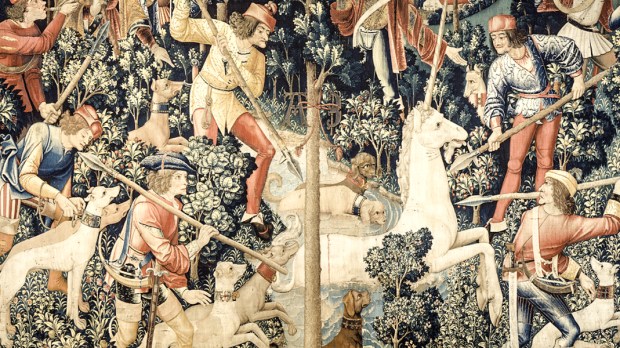Lenten Campaign 2025
This content is free of charge, as are all our articles.
Support us with a donation that is tax-deductible and enable us to continue to reach millions of readers.
Also known as “The Hunt of the Unicorn,” the Unicorn tapestries are not only the most treasured artworks in permanent display at the Cloisters (the Upper Manhattan home for the Metropolitan Museum of Art’s Medieval Collection); these seven magnificent tapestries, in the words of Tiffany Jow, “are widely considered to be among the greatest artworks in existence.” But that doesn’t mean these masterpieces, woven from wool and silk threads covered in gold and silver, are not themselves cryptic. In fact, some of the cycle’s most intricate details and deep symbolism are still controversial, as scholars still try to uncover the many layers of covert references one might “read” in them.
Read more:
When Unicorns Go to Church: A Mosaic in St. John the Evangelist’s Basilica in Ravenna
On the many unsolved mysteries one finds in these Tapestries are the “AE” ciphers one finds in every hanging. Some have said these letters mean “Adam and Eve,” giving “The Hunt of the Unicorn” a mystical meaning, following certain legends commonly associated to these mythical beasts. Some others claim these letters identify Anne of Britain, who was a major patron for the arts. Most recent theories, explained by Tiffany Jow in her article published in Artsy, claim “the letters represent Antoinette of Ambroise, the wife of François de La Rochefoucauld’s second son, Antoine, who was born around 1475.”
Unicorns, difficult as it is to believe, are mentioned in the Bible — not one, not two, but nine times in total. Most biblical scholars point out that this is a mistranslation of the Hebrew word re’em, which means “ox” or “buffalo.” Some other point out that this re’em instead refers to a rhinoceros, as the beast is described in the bible as an incredibly strong animal. Interestingly, there are one-horned rhinos, which would make the presence of the unicorn-re’em beast in the biblical text something a little more consistent.
Read more:
Dragons, unicorns, cynocephali: the favorite monsters of the Middle Ages
Translation aside, the fact is that the unicorn, as a mythical figure, found a place of its own in Christian iconography, to the point of becoming a Christological symbol. Strange as it may seem, the unicorn is considered to be an image of Christ in medieval iconography, and the whole series of tapestries might be just a “meditation” on this Christological motif. But why is this beast associated with Christ at all?
A medieval legend based on the Physiologus (a text of the 2nd century, written by an anonymous Alexandrian author) describes the unicorn as an animal impossible to capture by anyone but a virgin. Attracted by the purity of an immaculate maiden, the unicorn would sleep in her lap. In fact, one of the tapestries in cyvle is called “The Mystic Capture of the Unicorn.” Only while the unicorn was asleep in the lap of the virgin could the hunters catch him.
This legend was understood and read by Christian exegetes as an allegory of the Incarnation of Christ: the Creator of the Universe, impossible to contain, makes himself human and vulnerable in the womb of Mary Immaculate.

